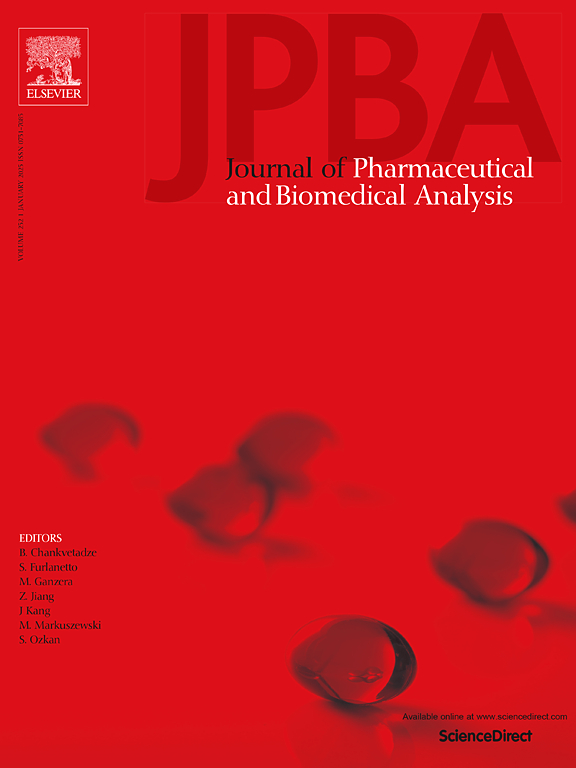Pediatric formulations and challenges beyond technological development: Identification and in silico qualification of impurities in 5 mg primaquine tablets
IF 3.1
3区 医学
Q2 CHEMISTRY, ANALYTICAL
Journal of pharmaceutical and biomedical analysis
Pub Date : 2025-04-11
DOI:10.1016/j.jpba.2025.116861
引用次数: 0
Abstract
The present paper outlines the crucial analytical procedure for registering primaquine 5 mg tablets for pediatric use. In order to meet regulatory guidelines, the impurities detected during the long-term stability study of the tablets were identified and qualified. A C18 column was used for stability indicating chromatographic separation. Chromatography was conducted using a binary mobile phase comprising TFA 0.05 % and ACN at a ratio of 78:22 v/v for mobile phase A, and ACN for mobile phase B, in a gradient mode, at a flow rate of 0.8 mL min-1 and the wavelength was monitored at 265 nm by DAD. The elution times for the degradation products that reached the identification limit at 24 months were 15.87 min and 19.46 min for DP-2 and DP-3 respectively. LC-HRMS analysis of DP-2 and DP-3 resulted in identifying a protonated molecule peak with m/z values of 517.32599 and 461.21567, respectively. Elemental compositions of DP-2 and DP-3 were C30H41O2N6 and C26H29N4O4, correspondingly. DP-2 safety was assessed via in silico analysis and qualified with a specification of 0.6 %. DP-3, although finding its full identity was not possible, it was assigned a conservative specification of 0.5 % for the drug product. Our research has emphasized the significance of analytical development in enabling the evaluation of drug product quality and safety in the submission dossier. These results underline the challenges of analytical development in drug product lifecycle.
儿科配方和超越技术发展的挑战:5 mg伯氨喹片剂中杂质的鉴定和硅定性
本论文概述了注册儿童使用的伯氨喹5 mg片的关键分析程序。为满足药典要求,对片剂长期稳定性研究中检测到的杂质进行了鉴定和定性。采用C18色谱柱进行稳定性分析。色谱采用二元流动相,流动相a为TFA 0.05 %,流动相a为ACN(78:22 v/v),流动相B为ACN(78:22 v/v),梯度模式,流速为0.8 mL min-1, DAD监测波长为265 nm。DP-2和DP-3在24个月达到鉴定极限的降解产物洗脱时间分别为15.87 min和19.46 min。对DP-2和DP-3进行LC-HRMS分析,鉴定出一个质子化的分子峰,m/z值分别为517.32599和461.21567。DP-2和DP-3的元素组成分别为C30H41O2N6和C26H29N4O4。通过计算机分析评估DP-2的安全性,并以0.6 %的规格合格。DP-3,虽然不可能找到其完整的标识,但它被指定为药品的保守规格为0.5 %。我们的研究强调了分析开发在提交档案中评估药品质量和安全性方面的重要性。这些结果强调了分析开发在药品生命周期中的挑战。
本文章由计算机程序翻译,如有差异,请以英文原文为准。
求助全文
约1分钟内获得全文
求助全文
来源期刊
CiteScore
6.70
自引率
5.90%
发文量
588
审稿时长
37 days
期刊介绍:
This journal is an international medium directed towards the needs of academic, clinical, government and industrial analysis by publishing original research reports and critical reviews on pharmaceutical and biomedical analysis. It covers the interdisciplinary aspects of analysis in the pharmaceutical, biomedical and clinical sciences, including developments in analytical methodology, instrumentation, computation and interpretation. Submissions on novel applications focusing on drug purity and stability studies, pharmacokinetics, therapeutic monitoring, metabolic profiling; drug-related aspects of analytical biochemistry and forensic toxicology; quality assurance in the pharmaceutical industry are also welcome.
Studies from areas of well established and poorly selective methods, such as UV-VIS spectrophotometry (including derivative and multi-wavelength measurements), basic electroanalytical (potentiometric, polarographic and voltammetric) methods, fluorimetry, flow-injection analysis, etc. are accepted for publication in exceptional cases only, if a unique and substantial advantage over presently known systems is demonstrated. The same applies to the assay of simple drug formulations by any kind of methods and the determination of drugs in biological samples based merely on spiked samples. Drug purity/stability studies should contain information on the structure elucidation of the impurities/degradants.

 求助内容:
求助内容: 应助结果提醒方式:
应助结果提醒方式:


